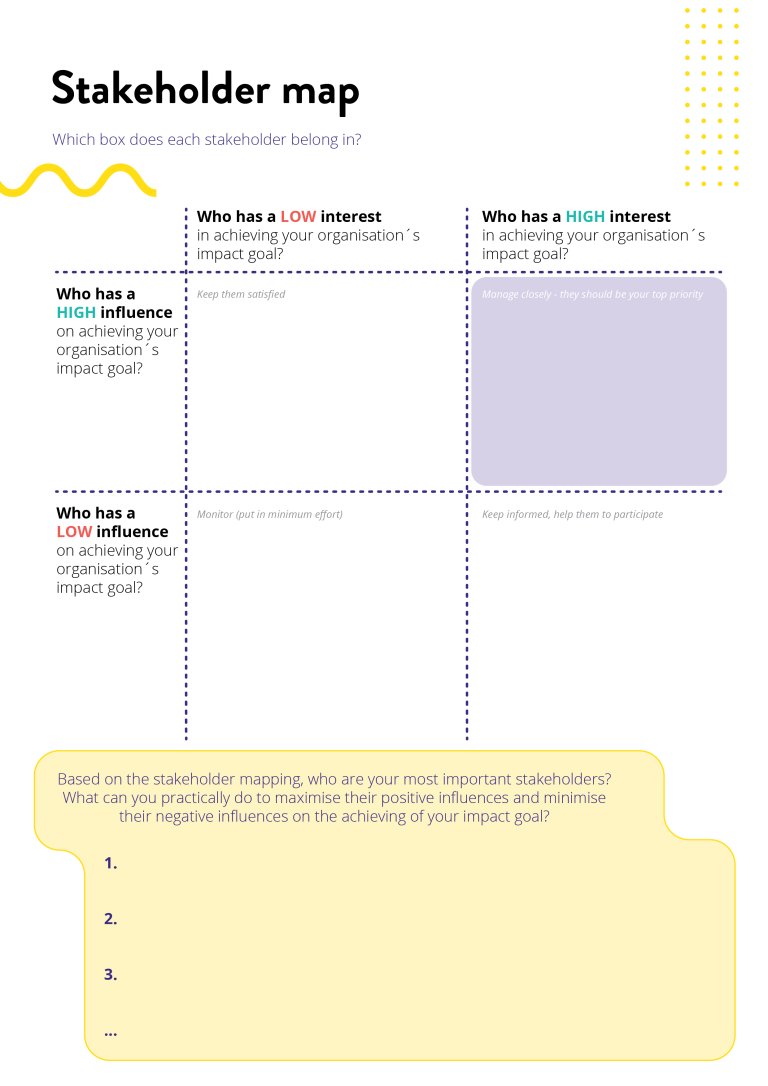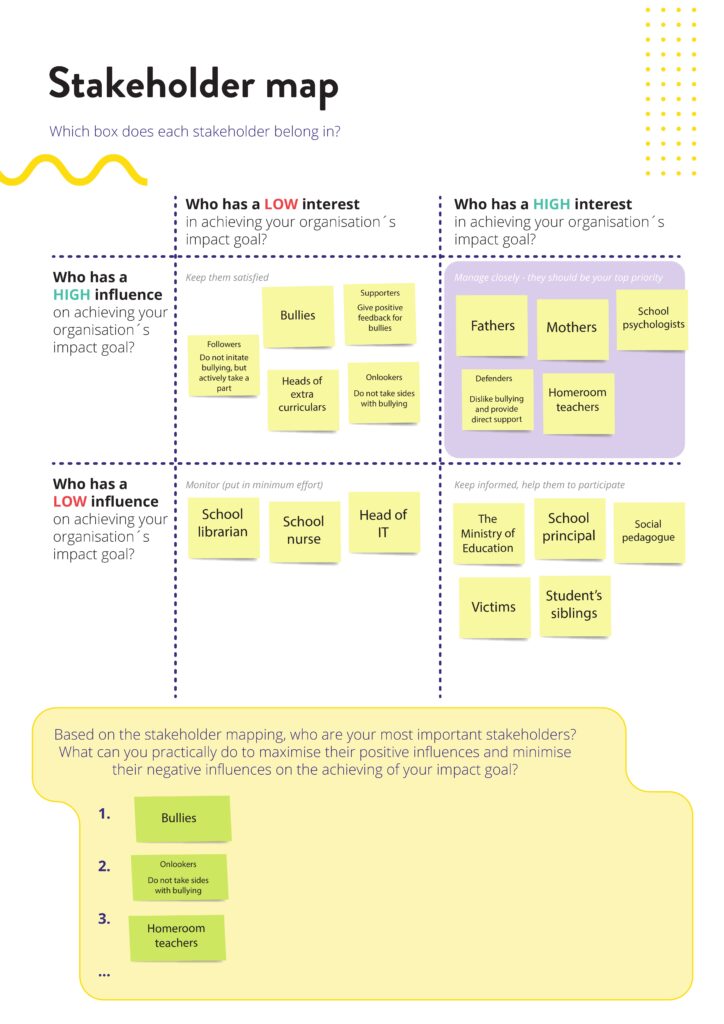A stakeholder map helps you analyse and manage relationships with individuals and organisations who are impacted by your solution or who can influence whether your solution will be successful.
So… what is it?
I’m glad you asked!
The stakeholder map helps your organization to find out who the stakeholders are that you need to focus on if you want to be successful.
The stakeholders can be groups of people (e.g. the youngsters you are working with or the volunteers that help to organise your activities) or organisations (e.g. schools that you need to cooperate with to reach the youngsters or the funders that provide you with grants) or influential individual representatives of organisations (e.g. a Head of Department of a Ministry or a leader of a large umbrella organisation).
The tool helps you to identify, analyse and successfully work with the stakeholders you need to influence to achieve your impact goal and prevent them from influencing your activities negatively.
It is useful to first fill in the goal tree because then you will have a clearer idea who are the stakeholders you need to focus on to:
- achieve your impact goal. That is because you usually need cooperation, funding and other actions from the stakeholders to achieve something as big and ambitious as your impact goal likely is,
- ensure the existence of the preconditions that need to be in place for your success. That is because ensuring the existence of the preconditions usually depends also on the actions of your stakeholders.
Sounds cool!
How does the tool look like?

Looks complicated. Quite many steps to take.
Could you walk me through it?
Sure! You can watch the video to get an idea of what the tool is about or continue reading after the video player.
Okay. How should I start?
This is what you should do.
1. Identify and map the activities that you need to undertake to achieve your impact goals. Include the activities that are needed to ensure the preconditions of achieving your impact goals. You can identify these preconditions with the help of the goal tree.
2. Brainstorm and write down all the stakeholders that are or may be important from the perspective of achieving your impact goal. Who can influence the success of your activities? Who will you influence with your activities and need to take responsibility for?
As mentioned before, the stakeholders can be groups of people or organisations or influential individual representatives of organisations.
And what do I do about the four empty boxes in the tool?
3. As you have already identified your stakeholders during the brainstorm at the previous step, place each of their names in an appropriate cell of the stakeholder map diagram. Placing the stakeholders would work the best with (virtual or physical) post-it notes: one note per stakeholder.
The exact location can be determined with the help of the scale. For example, the stakeholders with the lowest interest and highest influence in relation to achieving your impact objective (e.g. the potential participants that have currently a negative image of your organisation) should be placed on the top left side of the table.
Finding appropriate places for each of the stakeholders may take some time and discussion among your team as the team members may have different views about the relative interest and influence of your stakeholders.
And what about the bottom part of the tool?
4. Analyze your stakeholder map and make choices about the steps you need to take to manage the stakeholders that you need to influence and have a high impact on your success.
Two questions to help you have been provided:
- Who are your most important stakeholders?
- What can you practically do to maximize their positive influences and minimize their negative influences on the achieving of your impact goal?
Okay, just to be clear, could you repeat everything you said?
Sure! In a nutshell…
Decide about what you want to achieve: create a goal tree and identify your impact goal.
Then map the stakeholders:
- who you want to have an impact on,
- who can support you in / prevent you from achieving your goals.
The stakeholders can be groups of people sharing similar characteristics or organisations or influential individual representatives of organisations.
Write the stakeholders down in a list. Then put them in the following four categories and write down concrete actions to take (if needed) about each of the stakeholders.
1. Who can very much help you or get in your way AND are really interested in what you are doing?Put the most effort into making these people or organizations involved and happy. If they want to prevent you from achieving your impact objective, you can plan to take necessary preventive measures.
2. Who can very much help you or get in your way AND are not really interested in what you are doing? You have to make sure these people or organizations are happy with your work, but don’t put too much effort in – after all, they are not really interested.
3. Who can’t really help you or get in your way AND is really interested in what you are doing? Since they are interested, keep them informed, but don’t put in too much effort, since they can’t help you much.
4. Who can’t really help you or get in your way AND is not really interested in what you are doing? Put the least effort into interacting with these people, if any at all.
You can also have variations in its use
LIGHT: Write down the keywords based on your (team’s) experience, opinions, and gut feeling.
MEDIUM: Involve the representatives of the stakeholders in creating the stakeholder map.
ADVANCED: Do some research to understand better your stakeholder groups and differentiate between segments inside the stakeholder groups with varying degrees of “influence” and “interest”. The research can include interviews, focus groups, and asking for expert opinions.
I think I’m starting to get it now.
Could I see an example just to be sure?
Of course. Here is an example about a social enterprise that aims to increase the well-being of university students.
And here’s an example of a cyber-bullying prevention programme.

Okay thanks.
I understand how it works now but I’m still not sure if I should use this for my project or not.
When and why should I use the tool?
Here’s what the tool can help you with.
Why use it?
☑ To understand who exactly are the different groups of people and organizations that you need to involve and influence to achieve your impact objectives, e.g., young people you are directly working with, or the adults whose actions have a direct impact on the young people that you want to help.
☑ By using the stakeholder mapping tool you prioritize the stakeholders by the amount of influence and interest they have over achieving your impact objective. You can use this tool to choose which actions to take with each stakeholder and prioritize how much time to spend on them.
☑ To take responsibility for your actions that may negatively influence some groups of people during your activities. It is especially important regarding these stakeholders who have no power to directly influence your activities that might have a negative impact on them (e.g. young people who would develop quicker in other programs and thus waste their potential by participating in your activities, or youngsters who are required to attend your programs by other adults like their parents or social workers).
And here are some hints about the perfect moments when to use it
☑ Before developing your short-term objectives and activities (e.g. after choosing your impact objective and completing the goal tree based on the impact objective).
☑ When you want to make sure that you have identified all the risks and opportunities related to the groups of people and organisations who may have the interest and/or power to influence whether you will achieve your impact objective or not.
